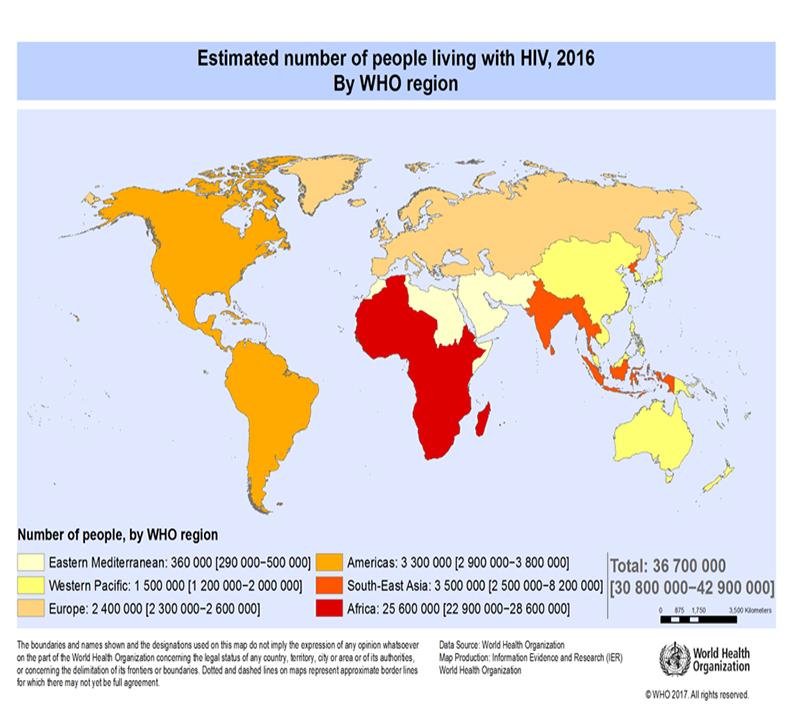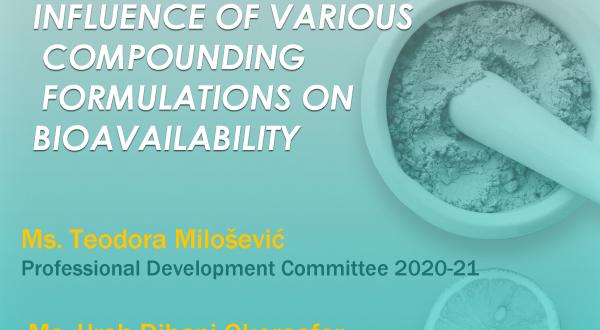
Policy Paper on Efforts to Combat HIV/AIDS
The International Pharmaceutical Students’ Federation (IPSF) is the voice of over 350,000 pharmacy students and recent graduates in 88 different countries worldwide.
According to various reports, the world is currently experiencing an AIDS epidemic. At this moment, 54% of adults and 43% of children living with HIV worldwide are receiving lifelong antiretroviral therapy (ART). In 2016, 1 million people died from HIV-related causes globally. The distribution of HIV across regions is highly heterogeneous, suggesting the need for regionally focused measures. Globally, 36.7 million people are living with HIV and prevalence among adults was 0.8 % in 2016. As a result, one target of the UN Sustainable Development Goal 3 (UN SDG3) is to end the AIDS epidemic by 2030.
Table I: HIV distribution across regions of the worlda.
|
Region |
Prevalence (in millions) |
Percentage of all population with HIV (%) |
Prevalence per 1,000 population (region)a |
|
Africa |
25.6 |
69.8 |
25.6 |
|
Americas |
3.3 |
9.0 |
3.3 |
|
Europe |
2.4 |
6.5 |
2.7 |
|
South-East Asia |
3.5 |
9.5 |
1.9 |
|
Western Pacific |
1.5 |
4.1 |
0.83 |
|
Eastern Mediterranean |
0.36 |
1.0 |
0.6 |
AIDS deaths are declining with expanding access to antiretroviral therapy, however, investments in treatment are being challenged by increasing morbidity and mortality associated with co-infections, such as hepatitis B and hepatitis C. Tuberculosis is still the leading cause of hospitalization of adults and children living with HIV, and remains the leading cause of HIV-related deaths (one third). More than half of the cases of HIV-associated tuberculosis are undetected, undermining access to lifesaving antiretroviral therapy.“Although HIV incidence is in overall decline, it is increasing in some regions and countries. Adolescent girls and young women in sub-Saharan Africa are being infected at twice the rate as that of boys and men of the same age. In addition, there are substantial disparities in access to treatment and care, with boys and men lagging behind in many countries. Human rights violations, along with widespread gender-based violence and stigmatization and discrimination, continue to hinder access to health services, particularly for children, adolescents, young women and key populations.
HIV has a profound impact on hepatitis B virus and hepatitis C virus infection, resulting in higher rates of chronic hepatitis infection, accelerated fibrosis progression with increased risk of cirrhosis and hepatocellular carcinoma, and higher liver-related mortality.
Those disproportionately affected by HIV epidemics in all regions, have been identified as: men who have sex with men, people who inject drugs, sex workers, transgender people and prisoners.
People living with HIV are at increased risk of developing a range of noncommunicable diseases as a consequence of their HIV infection or related to side-effects of their treatment or ageing, including cardiovascular disease, diabetes, chronic lung disease and various cancers. Common mental health comorbidities include depression, anxiety, dementia and other cognitive disorders.” (WHO Global Health Sector Strategy on HIV, 2016-2021)
Recognizing the global health implications of HIV/AIDS, IPSF carries out an annual global public health campaign on December 1st (World AIDS Day). The campaign mostly revolves around disease awareness, education and in some cases, even testing for the disease.
In 2016, the IPSF Public Health Committee prepared step-by-step guidelines on organising such a campaign, along with a booklet and multiple posters for the use of IPSF member associations. Throughout the campaign window, member associations altogether reported an audience reach of over 20,000 individuals, with the most in the IPSF Eastern Mediterranean Region (IPSF EMRO).
These activities included:
-
Educating the public about the importance of awareness, testing and prevention regarding HIV (SAFPUM, Bosnia and Herzegovina)
-
Educating young children and teenagers aged 11 to 16 years about the causes and effects of HIV/AIDS and to prepare them to take serious precautions to prevent HIV infection (BUPS, Bangladesh)
-
Organizing lectures to educate students about HIV (NAPSer, Serbia)
-
Performing Hepatitis B, HIV testing and counselling (MUPSA, Uganda)
-
Spreading awareness through online campaigns and offline campaigns throughout the country, including making creative materials to combat the stigma surrounding HIV/AIDS (EPSF, Egypt)
-
Volunteering at a concert to support people infected with HIV and to raise awareness about HIV. Collaborating with other organizations and handing leaflets and condoms out to the public. At all the venues, a new smartphone application “Spolno zdravlje” (sexual health) was promoted through leaflets. CPSA volunteers also made a QR code so the application would be more accessible. The application serves as a great educational tool, since it familiarizes this topic to the public through many articles and quizzes. (CPSA, Croatia)
-
Promoting HIV awareness via national radio (ASEPA, Algeria)
-
Educating students about HIV through workshops, performing HIV testing, and holding social media campaigns (FEEF, Spain)
In the 2017 campaign, IPSF and its members have carried out the following:
-
Photo Challenge
-
15 member associations from 15 different countries participated in the photo challenge (as of records from 11/23/17)
-
Member associations were encouraged to share their photos on their respective social media pages
-
-
-
An updated informational booklet was created about HIV/AIDS to be used by member associations during their public outreach activities
-
-
Posters
-
Informational posters were created about HIV/AIDS to be used by member associations during their public outreach activities as well as to be shared on social media
-
Topics:
-
Debunking common myths about HIV/AIDS
-
Reducing a person’s risk of acquiring HIV/AIDS
-
-
For 2017, The IPSF European Regional Office has partnered with the European Pharmaceutical Students’ Association (EPSA) to raise awareness about HIV under the #LetsEndIt slogan, the official social media handle for World AIDS Day.
IPSF believes HIV/AIDS is the concern of every world citizen. While some regions are more affected than others, AIDS persists globally. As pharmacy students and recent graduates, IPSF continues to raise awareness and bring solutions from a youth perspective.
As members of the global community, we need to ensure both the availability and accessibility of antiretroviral treatments to those living with HIV. Access to medicines still poses a broad challenge which needs to be addressed from multiple viewpoints. Additionally, the concurrent rise of noncommunicable diseases (NCDs) significantly contributes to the financial burden of HIV/AIDS to health systems around the world.
The WHO “Treat All” recommendations are, and will be, an invaluable tool in ending AIDS by 2030. By the end of 2017, 75% of all LMICs and 94% Fast-Track countries will have adopted the “Treat All” approach.
Furthermore, we need to focus national health-care strategies and local awareness campaigns on identifying HIV status and promoting HIV testing services. Pharmacies in the US, for example, have been evaluating the benefits of HIV screening in pharmacies themselves. This is a key tool for optimizing HIV prevention, as well as achieving early and effective treatment.
Member states should provide well-rounded care for HIV patients by linking HIV services and the most common comorbidities/coinfections services, such as those for tuberculosis, viral hepatitis, NCDs, mental health and substance use disorders. This allows for integrated patient-centered care and the better utilization of resources.
HIV prevention tools need to be promoted on a local level, as well as part of national prevention programmes, such as condom usage in sexually active persons and the use of sterile needles and syringes in people who are drug dependent.
IPSF shall continue the practice of educating the general population and raising awareness through its annual campaign.
aCalculated through WHO HIV regional prevalence data vs WHO Regions and other population data. Population in millions; Africa (1000), Europe (900), South-East Asia (1860), Americas (1002), Eastern-Mediterranean (583), Western Pacific (1800).
References:
WHO Regional Offices Population Data
https://ourworldindata.org/hiv-aids/
http://www.who.int/mediacentre/factsheets/fs360/en/ (updated July 2017)
http://www.who.int/hiv/data/epi_plhiv_2016_regions.png?ua=1
http://apps.who.int/iris/bitstream/10665/246178/1/WHO-HIV-2016.05-eng.pdf?ua=1
WHO Global Health Sector Strategy on HIV, 2016 - 2021
https://www.walgreens.com/topic/hiv-pharmacy-services/hiv-testing.jsp
IPSF Internal Public Health and Other Archives



